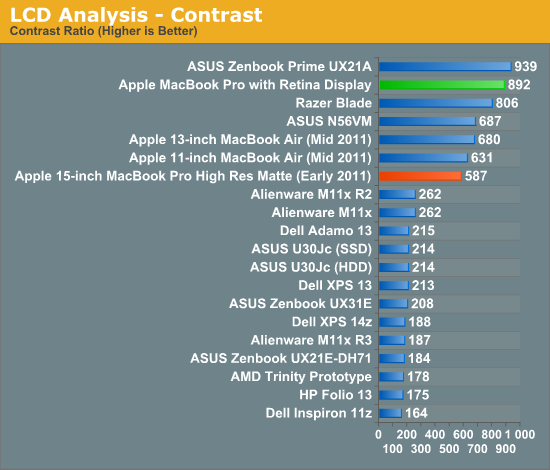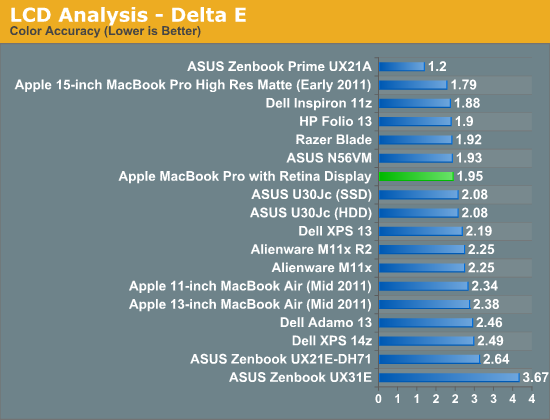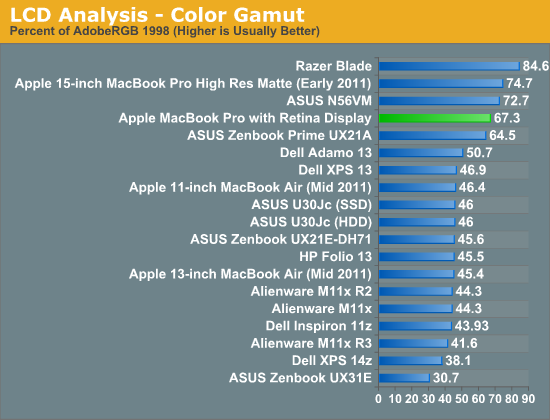The next-gen MacBook Pro with Retina Display Review
by Anand Lal Shimpi on June 23, 2012 4:14 AM EST- Posted in
- Mac
- Apple
- MacBook Pro
- Laptops
- Notebooks
The Retina Display in Numbers
I already published preliminary analysis of the Retina MacBook Pro’s display. In short brightness is down a bit, black levels are considerably improved and contrast as a result takes a huge step forward compared to previous models. My personal MacBook Pro used the anti-glare matte screen and the improvement in contrast ratio compared to that reference is over 50%.



Apple made no mention of impact to color accuracy or color gamut. It turns out that the omission was for good reason, the Retina Display offers no improvement along either vector. The numbers show a slight regression compared to last year’s panel but the difference is imperceivable.


Technically Apple’s use of the word Retina in reference to a display only refers to the inability for the human eye to resolve individual pixels at a specified distance (18-inches for the MacBook Pro). In practice however Apple has delivered tightly integrated IPS panels with wonderful performance characteristics as a part of the Retina brand. I do hope that for the years to come Apple does not compromise on these fronts.










471 Comments
View All Comments
EnzoFX - Saturday, June 23, 2012 - link
Tell MS to buy them then. Can you really not see how Apple forcing this, makes others want to compete?UberApfel - Saturday, June 23, 2012 - link
You must be new to economics.ciparis - Saturday, June 23, 2012 - link
Because there were so many 2800-class displays on notebooks before Apple introduced them. Or desktop for that matter.Innovating while securing your own future production capacities, even if it means others will have a hard time copying you, is a perfectly reasonable business decision.
Taft12 - Monday, June 25, 2012 - link
Perhaps they really did buy 'em all, but anticompetitive would be preventing any more factories capable of producing high-resolution displays from coming into existence. Now *THAT* would be impressive!OCedHrt - Saturday, June 23, 2012 - link
Already exists on PC. And in 2012 Apple introduces DPI scaling? Windows had this in XP if not earlier.Akdor 1154 - Saturday, June 23, 2012 - link
yes, and it STILL isn't up to par, even with Windows 7. You can see on the shots in the review how well it performs - titlebars are too small, icons are nastily pixellated (as it can only go up to 1.5x, not a round 2x), and third party support is patchy at best. (As an aside, I would be very interested in an article on the differences on high-res drawing APIs between Windows and Mac OS. )Microsoft got there first with a half-done approach, Apple polished it.
N.B. I'm a happy Windows user, but this particular piece of tech is making me quite jealous..
internetf1fan - Saturday, June 23, 2012 - link
" (as it can only go up to 1.5x, not a round 2x)"Anand is wrong. They looked at only the preset options given by Windows which are 100%, 125% and 150%. Had they bothered to look at the other options, they would have noticed that you can easily set the custom DPI at 200% to get a x2 behavior you want. This review is seriously shoddy.
fmcjw - Saturday, June 23, 2012 - link
Yes, never seen Anand totally gushing like this. It's as if he can justify all the non-upgradeable design quirks and incompatibility with existing applications, simply by gazing at the hi-res display. I don't think many can distinguish pixels on a 13" FullHD, or even an 11" 1366x768 at normal viewing distances.In his bias and self-deception he glossed over flaws and uses the resolution as the way out of every flaw. Isn't the old matte display better than the new fancy "low-gloss" glossy display? Anand failed to look into the battery type integrated, whether it's one of the 1000-cycle packs. More unforgivably, he glossed over the low color gamut aspect, omitting a common sRGB comparison table.
Until I see a demo unit, I'll stick to the view that this is just a gimmick to lock in users by favoring proprietary, Retina-optimized applications, while 95% of applications are better off in FullHD/1920x1200 on a laptop.
This review is proof that even one of the most professional reviewers can be blinded by his own self-deception and pretty looks.
themossie - Saturday, June 23, 2012 - link
What proprietary, Retina-optimized applications? You're already running Mac OS X, it's not gonna get any more proprietary :-)The maximum selectable resolution on the MBP Retina Display -is- 1920x1200. When you select 1920x1200, it renders at 3840x2400 and downscales the image to 2880x1800.
Can easily distinguish pixels on an 11" 768p machine - I use one on a daily basis. 13" 1080p from normal viewing distance is much harder to distinguish.
damianrobertjones - Sunday, June 24, 2012 - link
"New super resolutions are coming to notebook/ laptop computers. Thanks to Apple and their forward looking business sense. Wonder when it comes to PCs..... with Windows 8?"Pointless on smaller screens.